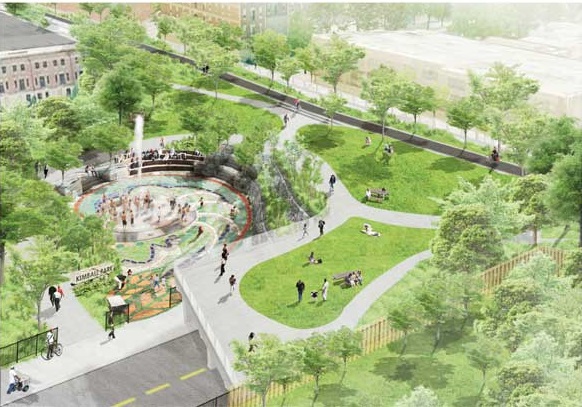CHICAGO — On an abandoned Chicago railway line cutting between the treetops, bike commuters zip by walkers and joggers, all traversing a ribbon of concrete undulating through a lush landscape where clattering freight cars once ferried everything from coal to furniture.
This relic of the city’s industrial past is now a vision of its future. Chicago and cities throughout the country are transforming hulking pieces of obsolete infrastructure into useful — even inspiring — amenities: In this case, a park in the sky that doubles as an alternative transportation corridor.
Since opening in June, the nearly three-mile elevated path, called the Bloomingdale Trail, has changed how residents move through a section of Chicago’s northwest side that in many places is starved of parks and inviting pathways for pedestrians and bikes.
“This trail opened up a lot of opportunity for me,” said Luke Young, a 30-year-old web developer who now bikes the 10 miles to his job downtown instead of taking the train; it takes roughly the same time. Moving by bike, though, is more fun and a way to relieve stress, he said before tearing down a ramp that links the trail to Milwaukee Avenue, a busy thoroughfare popular with cyclists.
“This is really an innovative park for a resurgent city and it’s an example of the way cities are coming back to life in the U.S.,” said Ed McMahon, a senior fellow at the non-profit Urban Land Institute in Washington.
After decades of decline, American cities are getting creative in rolling out new green spaces to sell their brand. With little real estate to expand on, McMahon said, cities are turning instead to the wreckage of past eras: old rail yards, landfills, utility corridors and riverfront areas cut off by freeways.
Dallas built a deck over a freeway to create Klyde Warren Park. Virginia Beach, Virginia, turned a landfill into an expanse of lakes, hills, playgrounds and a skate park that it playfully calls Mount Trashmore. Savannah, Georgia, buried a parking garage to restore one of the original town squares laid out in the 1700s.
Elevated rail lines especially have beckoned, tapping into utopian visions of parks and pathways in the sky. There’s Manhattan’s High Line and Paris’ Promenade Plantee. But the Bloomingdale Trail pushes into new territory: It’s longer, allows bikes and links a string of ground-level parks. The park and trail system is known collectively as The 606 — a reference to the first three digits of the city’s zip codes.
Its linear shape extends access to a huge number of people across four neighbourhoods. The 17-foot-high rail embankment, once a physical dividing line, is now a connector and a gathering place for communities as diverse as Humboldt Park, the centre of the Puerto Rican community, and Bucktown, a recently gentrified neighbourhood that’s home to cool cafes and doggy daycare centres.
But some neighbourhood groups fear it could push lower-income residents out by contributing to rising property values, rents and property taxes. City leaders say they want to prevent that.
“How are working families going to be able to enjoy this trail and also be able to afford living where they’re living?” said Juan Carlos Linares, director of the Latin United Community Housing Association.
On a hot August morning, bikers shot up and down The 606, office IDs fluttering, GoPro cameras mounted to helmets, earbuds piping in the tunes, as they zoomed to jobs, meetings and construction sites. In the glow of sunrise, joggers and moms with strollers glided along a narrow, rubbery strip along either side. An older man buzzed by in an electric wheelchair.
Dina Petrakis, a 57-year-old remodeling consultant, biked with her tiny dog, Lucy, poking its head out of a shoulder satchel. Petrakis mainly uses the trail to get to yoga class.
” used to have to drive because you can’t really ride your bike over there. Streets are too busy,” she said.
Designers carved pleasing dips and curves into the path. Short gravel side loops take walkers into shady tree-filled groves. The embankment widens in places into spacious overlooks. The western trailhead includes a spiraling earthwork in the design of an ancient solar observatory, and there are plans for a skate park and art installations.
The safety of the trail got Jim Trainor back on the bike that he’d ditched after his wife got hit by a car door while cycling. Now, the 54-year-old professor of animation at The Art Institute of Chicago rides every morning for exercise and serenity.
“It’s kind of a godsend for me,” he said.
